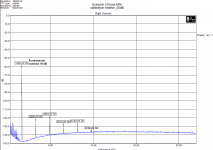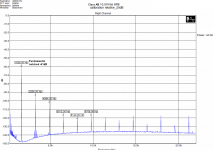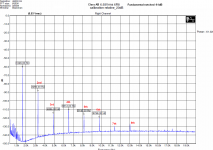Ahh, but if it's not a "prime quality" recording can we do that? That's the key for me - to put on a "dodgy" recording, daggy bits hanging off the edges and all; and just go with the flow of the music making, not be irritated by "imperfections" that are part of, will always be part of the package ...
Here you go Frank play at 11 please...Moondog (Usa, 1956) - Full Album - YouTube
Hi,
Asked to resume human life in a nutshell he replied: 2 trumps 1.
Cheers,
I miss my visits to Grande Place, maybe we could meet over some frites with mayo some day?
No George, I do not exaggerate, I was present when one of them was being opened up.
I don't know what the books say, but I know what I saw and got a piece of. I cannot vouch that each and every one was made the same way, after all, it was wartime and silver was not easy to get, especially in the later stages of the war.
As I said earlier they do not use silver cables these days in vehicular comms, just copper.
Hi,
Yes, I can try. It is not unlike using a more refined lens on a camera.
Better defined focal image is what comes to mind.
To put it in your own language, a tiny bit more of that so illusive "correctness" perhaps ?
Cheers,
Measurements, not anecdotes, some hard proof please would be nice.....If it is noticeable then there must be a measurable difference.
Measurements, not anecdotes, some hard proof please would be nice.....If it is noticeable then there must be a measurable difference.
I agree. Please let me bring an example from amplifier measurements, I apologize it is not about wires.
In case I precised my measurement methods (using notch filter) to be able to measure reliably down to less than -130dBr, I was told it would be inaudible, though the listening test says the opposite.
So the ability to measure a difference does not tell it would be accepted as a proof.
Attachments
So the ability to measure a difference does not tell it would be accepted as a proof.
Unfortunately yes. There SHOULD be differences, but whether there is CORRELATION (with that differences) or not is the question.
I wonder, when people ask for measurement, do they really know what measurement they are looking for (to see)??
Unfortunately yes. There SHOULD be differences, but whether there is CORRELATION (with that differences) or not is the question.
I wonder, when people ask for measurement, do they really know what measurement they are looking for (to see)??
If we do not investigate and obtain some metrics how can we quantify when we think we perceive a difference, and further how can we then work out what is causing the change without measurements.
As to cable directivity, based on how the wire is drawn...how do we equate this to screened cables with the return travelling through the screen...so far I have seen claims of this and copper crystal boundaries etc used, but one of the cable constructions this is claimed for are co-axial, so how does the directivity equate to this when half the signal is passing through a screen.
PMA measurements will tell us if there is a difference as apposed to just some belief that appears only in high end esoteric audiophile circles...
As I said earlier they do not use silver cables these days in vehicular comms, just copper.
Marce, that was 70 years ago, for Pete's sake.
I would not be surprised to hear that current day technology makes OFC cabels which are measurably better than the silver of 1944.
So the ability to measure a difference does not tell it would be accepted as a proof.
Depends. If the measurement shows differences in factors demonstrated to be audible at levels above thresholds demonstrated to be audible, then that's good proof.
If otherwise, then the way to demonstrate an audible difference is to demonstrate an audible difference: ears only.
Marce, that was 70 years ago, for Pete's sake.
I would not be surprised to hear that current day technology makes OFC cabels which are measurably better than the silver of 1944.
I know, but why would they use silver, is it because their rf technology was cutting edge and the copper cable was not up to it due to not very good manufacturing techniques/crappy dialectrics?
Fairs fair, you did use it as an example of the benefits of silver wire, now we will have the super cable manufacturers coming out with Tiger brand silver cable, military spec, reverse directionally rolled each die change to reduce crystal stripes and improve resistivity.
The 7th - another popular topic
Attached please find another measurement of class AB amplifier. Please note very low 7th harmonic, at -130dBr.
I just made a file with only 11396Hz at -130dB. I couldn't hear it at all with normal listening levels.
And you have done it well. The 7th like an indication of possible crossover distortion resulting from output stage operation. You know, with a complex signal, high order class AB/B distortion acts like noise bottom elevation and noise bottom modulation at normal listening level.
Thanks for the FET CISS info. I think I will measure the loss across the gate stopper resistor and go from there. A risky thing to do.
I thought I should put my minimum cost wire and connectors up for others to benefit from. By pure chance I came across this cable. I bought it for making up cables in emergencies. The price has risen by less than copper prices since I bought mine! This will probably sound better than any shop bought cable, the reason being everything is as good as it easily can be. The Rean RCA plugs are work of art. They put the Profi ones of the same company to shame ( Profi brakes hot and ground together, the spring takes the signal ). I suspect if RCA plugs can have a sound the Profi are nasty. Unlike most people I am not put off by one product. The Profi was the one I tried first. The Rean plugs and the cable seem to have super solderability. I have gone back to lead-tin-silver solder as the way it all works is important.Some may have mistaken the way silver solders for better sound. 4% silver helps gold bond to copper. Tin only solder seems to be like concrete that didn't set correctly. Silver again helps that. If anyone doubts that the eutectic of the solder with added silver is lower by a reasonable margin. In fact way below that of any of the metals in the alloy. The silver alloy is in fact behaving as a unique metal. It is not amorphous as some used to think. Obvious if you think about it. The electrons have interesting new partners and choose new ways of behaving. Alchemy and science. The typical temperate reduction using 4% silver is 10 C. Something that is that dramatic must be doing something. My feeling is the silver loaded solder alone might be a good percentage of what silver does? For SMD a wonderful advantage if hand soldering. BCV 61/62 for example.
Audioquest said one very interesting and logical thing. Use as little solder as you can. Crimp and solder ( often the gold flakes off ). The Rean plug wet very easily. They almost suck the wire to them. This cheap wire also seems to pull the solder off of the iron. I suspect although very cheap it really is OFC. The only advantage of OFC is it is a delight to solder. I tend to avoid tinned cables. Playing extra for a risk of a worse result. I think I notice it solders less well? I also avoid cheap silver plated as I am convinced it is bad news. It might be 92% purity which means dreadful other contaminants.I doubt it but not worth the risk.
Like my bottles of Cava price is also the question. Cava is more remarkable as it brakes every rule of good wine production. The little things they can do makes the difference.
The thing to say is this. Even allowing for that some cables might be worth extra how would you every know?
I include DIN as to me it is vastly superior. The cable if heat shrink covered will fit DIN. The reason DIN is better is the fact signal ground and RF ground can be separated with no great effort. The Rean RCA sockets also help that as they seem always to guide themselves in and not short to the casework. I also like how much can be packed in. A 7 pin DIN on an amplifier I made gave extra inputs and headphone / preamp out. That was using the class a op amp trick ( NE 5532 or better and 5 mA CCS, it's enough ) . The distortion was very low and I supect universally better.
These are the connectors.
Gold Plated Phono Plug Red Nys373 2 | Rapid Online
Nys367 0 Gold Plated Phono Socket Bck | Rapid Online
5 Pin 180 Deg.metal DIN Plug | Rapid Online
CBBR4166 - PRO POWER - CABLE, 18/0.1, SCRN, 100M | Farnell UK
I thought I should put my minimum cost wire and connectors up for others to benefit from. By pure chance I came across this cable. I bought it for making up cables in emergencies. The price has risen by less than copper prices since I bought mine! This will probably sound better than any shop bought cable, the reason being everything is as good as it easily can be. The Rean RCA plugs are work of art. They put the Profi ones of the same company to shame ( Profi brakes hot and ground together, the spring takes the signal ). I suspect if RCA plugs can have a sound the Profi are nasty. Unlike most people I am not put off by one product. The Profi was the one I tried first. The Rean plugs and the cable seem to have super solderability. I have gone back to lead-tin-silver solder as the way it all works is important.Some may have mistaken the way silver solders for better sound. 4% silver helps gold bond to copper. Tin only solder seems to be like concrete that didn't set correctly. Silver again helps that. If anyone doubts that the eutectic of the solder with added silver is lower by a reasonable margin. In fact way below that of any of the metals in the alloy. The silver alloy is in fact behaving as a unique metal. It is not amorphous as some used to think. Obvious if you think about it. The electrons have interesting new partners and choose new ways of behaving. Alchemy and science. The typical temperate reduction using 4% silver is 10 C. Something that is that dramatic must be doing something. My feeling is the silver loaded solder alone might be a good percentage of what silver does? For SMD a wonderful advantage if hand soldering. BCV 61/62 for example.
Audioquest said one very interesting and logical thing. Use as little solder as you can. Crimp and solder ( often the gold flakes off ). The Rean plug wet very easily. They almost suck the wire to them. This cheap wire also seems to pull the solder off of the iron. I suspect although very cheap it really is OFC. The only advantage of OFC is it is a delight to solder. I tend to avoid tinned cables. Playing extra for a risk of a worse result. I think I notice it solders less well? I also avoid cheap silver plated as I am convinced it is bad news. It might be 92% purity which means dreadful other contaminants.I doubt it but not worth the risk.
Like my bottles of Cava price is also the question. Cava is more remarkable as it brakes every rule of good wine production. The little things they can do makes the difference.
The thing to say is this. Even allowing for that some cables might be worth extra how would you every know?
I include DIN as to me it is vastly superior. The cable if heat shrink covered will fit DIN. The reason DIN is better is the fact signal ground and RF ground can be separated with no great effort. The Rean RCA sockets also help that as they seem always to guide themselves in and not short to the casework. I also like how much can be packed in. A 7 pin DIN on an amplifier I made gave extra inputs and headphone / preamp out. That was using the class a op amp trick ( NE 5532 or better and 5 mA CCS, it's enough ) . The distortion was very low and I supect universally better.
These are the connectors.
Gold Plated Phono Plug Red Nys373 2 | Rapid Online
Nys367 0 Gold Plated Phono Socket Bck | Rapid Online
5 Pin 180 Deg.metal DIN Plug | Rapid Online
CBBR4166 - PRO POWER - CABLE, 18/0.1, SCRN, 100M | Farnell UK
Thanks for the FET CISS info. I think I will measure the loss across the gate stopper resistor and go from there. A risky thing to do.
An easy way to do is to increase a gate stopper to something like 1k and then just measure amplitude response. Find -3dB drop and use simple formula
F = 1/(2*pi*R*C)
to calculate C.
And ...Here you go Frank play at 11 please...Moondog (Usa, 1956) - Full Album - YouTube
As people commented, pretty remarkable for 1956 - creativity is a fascinating thing ...
If we do not investigate and obtain some metrics how can we quantify when we think we perceive a difference, and further how can we then work out what is causing the change without measurements.
Agree. May be I'm lucky that I can trust my ears. This way I can simulate or measure amplifier/speaker designs which sound has been recognized by my ears. Ears guided me to find what differences are responsible for the sound that I heard.
It may sounds silly but effective. For example, I hear good bass in amp A, B, C and weak bass in amp X, Y, Z. Then I check the Fourier transform, with windowing styles that exaggerate the relative difference between the amps. Then I found a standard how an FFT should look like, minimum, to be good enough with bass. Then from that visual information I tried to find the reason why such FFT related with bass quality, and then I concluded that bass is affected by noise at low frequency. Correct or wrong doesn't really matter as I trust my ears. But when it is correct/relevant, it help me to repeat the performance that I'm looking for.
There are MANY things like that, that can only be done in design/simulation level. Commercial product measurement usually only related with finished product which is not too useful. For example, the distortion prior to giving feedback cannot be measured from final design.
And only with comparing ears perception with numbers I can set MINIMUM REQUIREMENT for each parameter.
Sometimes, I found some important thing from reviewing my documentations, where in the documentation each design has a note regarding my listening perception.
So I can't understand why some objectivists cannot accept that the "usual" measurement DO NOT represent the overall sound quality at all.
That's why I wondered or questioned those who often ask for measurement result, what measurement that they specifically expect to see? And by what wisdom they will draw the conclusion??
As to cable directivity, based on how the wire is drawn...how do we equate this to screened cables with the return travelling through the screen...so far I have seen claims of this and copper crystal boundaries etc used, but one of the cable constructions this is claimed for are co-axial, so how does the directivity equate to this when half the signal is passing through a screen.
Don't forget that theory may start from phenomena. An example of phenomenon is how our ears perceive the sound. From that we try to make a hypothesis by "logic". It doesn't have to be an absolute correctness. Just like human trying to explain how this world is formed, or whether God exist or not, often it is so silly, but that's all we have to explain the phenomenon. No phenomenon, nothing to explain.
"Skin effect" for example, is quite "logical". Logical here means that there is good correlation (and correctness) between Physics and phenomenon.
So things like "cable directivity" will sound so silly when seen from Physics alone. Just like those who believe that God exist are. But do not discount the fact that it was just an effort to explain a phenomenon.
- Status
- Not open for further replies.
- Home
- Member Areas
- The Lounge
- Sound Quality Vs. Measurements


